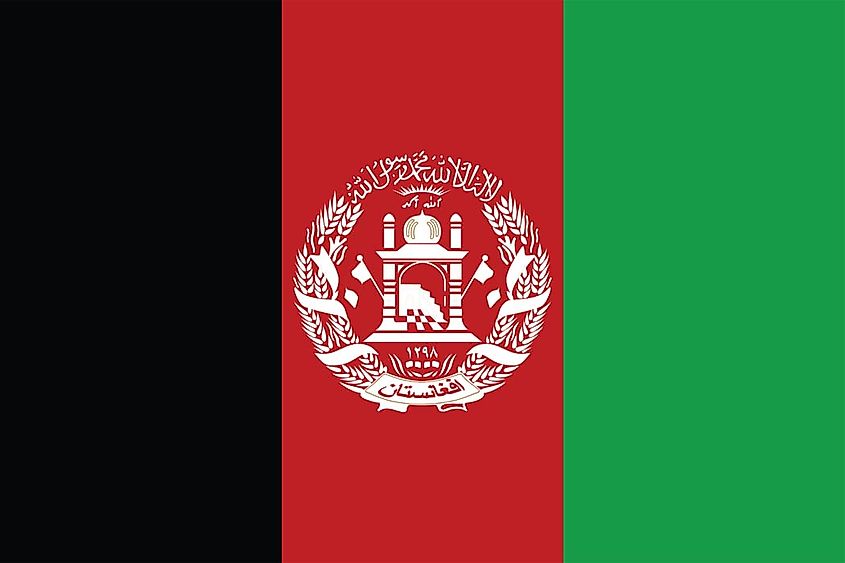Which National Flags Feature A Building?

National flags are designed and displayed by countries as patriotic symbols. Often times, the colors and designs hold great meaning. Of the many national flags, five feature buildings. The flags of Cambodia, Afghanistan, Portugal, Spain, and San Marino are the only flags that feature buildings in their emblems.
1. The Flag of Afghanistan

With a width to length ratio of 2:3, the current Afghan flag was adopted in August 19, 2013. The flag features a vertical tri-band of black, green and red, with a coat of arms at the center. The tri-band was first introduced by King Amanullah Khan in 1928 after his tour of Europe. The black signifies Afghanistan’s past, the red represents the blood shed during the fight for independence, and the green stands for the hope for a better future. The coat of arms is white and inscribed at the top is the Arabic for “There is no deity but God. Muhammad is the messenger of God.” Below this inscription is a mosque with the pulpit. Below the mosque is the name Afghanistan inscribed in Arabic. Two flags and two sheaths of wheat are on either side of the mosque and the Hirji year 1298 which represents the year 1918, the year Afghanistan got its independence, is inscribed where the sheaths meet in Arabic.
2. Flag of Cambodia

The current flag of Cambodia was first used between 1948 and 1970, after which it was replaced by the six other flags, and was reintroduced in 1993 when Cambodia became a monarchy. The flag has a width to length ratio of 16:25, and is made of horizontal tri-band of red and blue colors. The two blue bands are half the size of the centrally placed red band. The red symbolizes bravery and the blue cooperation, brotherhood, and liberty. An emblem of the Angkor Wat Temple is centrally placed in the red band in white. The temple is a world heritage site, built in the 12th century by King Suryavarman. It is currently the world’s largest religious monument.
3. Flag of San Marino

The Sammarinese flag is made of a horizontal dual band of white and light blue. The white symbolizes peace and blue liberty. The width to length proportion is 3:4. A coat of arms decreed on April 6, 1862 lies at the center. The coat of arms features a crown at the top symbolizing the sovereignty of the nation. Below is a blue shield, inside if which are the mountains and three towers. The mountains stand for the peaks of Monte Titano and the towers represent the citadels La Cesta, La Montale and La Guaita. Flanking the crown are branches of oak and laurel which represent stability and defense respectively. The motto LIBERTAS lies where the branches meet.
4. Flag of Portugal

The vertical bicolor flag of red and blue with a coat of arms was adopted on June 30, 1911. The green color represented hope while the red stood for the blood lost by those serving the country. The national coat of arms made of shield on an armillary sphere is in gold. The shield’s center hold five small blue shields with white dots that represents five gold coins (bezants) which represents the wounds of Jesus Christ. Seven castles are also found within the shield and they represent the Islamic moors Portugal conquered between 711 and 1492.
5. Flag of Spain

Bandera de Spanya, with a width to length ratio of 3:2, and a horizontal tri-band of red and yellow with a coat of arms is the official Spanish flag. The red bands are each half the size of the centrally placed yellow band. The coat of arms consists of a crown at the top, below it a shield with six compartments, flanked by two pillars with the motto Plus Ultra. Within the crown in the first quarter lies a three towered castles representing the Kingdom of Castile. A lion representing the Kingdom of Leon, four pallets gules representing the Crown of Aragon, and chains linked together representing the Kingdom of Nevante are in the second, third and fourth quarters respectively. At the center lies three lilies in a blue background representing the House of Bourbon. A pomegranate pod with two leaves ifs found at the bottom, between the third and fourth quarters, represents the Kingdom of Granada.











